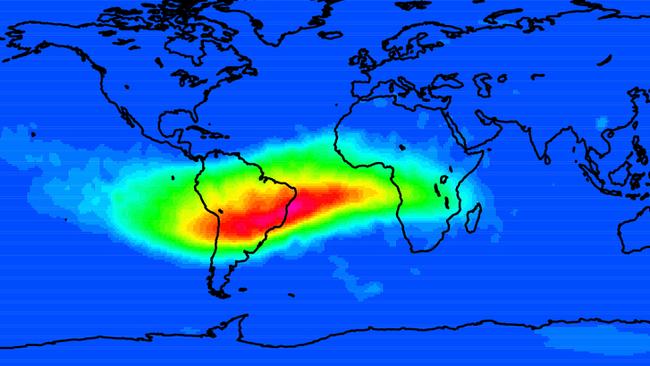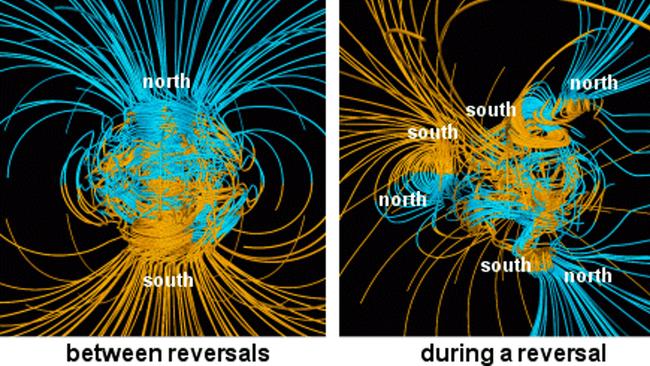South Atlantic Anomaly: Study reveals magnetic pole ‘wobble’ has been growing for 1000 years
SOMETHING odd is happening beneath the South Atlantic. It’s punching a hole in Earth’s radiation shield. It’s so bad, it’s killing satellites.

THERE’s a growing gap in the Earth’s defences.
We’ve known for more than a century that our planet’s magnetic field has been weakening.
It’s what gives us our north and south poles.
This powers our compasses.
It’s also a vital shield that protects us from harmful radiation constantly bombarding us from the Sun or deep space.
This weakening is most evident in one place. It’s a hole that reaches across the heart of South America, over the South Atlantic and into Africa.
It’s been dubbed the “South Atlantic Anomaly”.
It’s allowing more high-energy radiation to penetrate deeper through near orbit, the atmosphere and to our surface.
In recent decades it’s caused computers to crash on Shuttles and the International Space Station.
In 2016, Japan’s revolutionary Hitomi X-ray observation satellite that was supposed to study black holes and supernovas was struck while passing through the gap and sent spinning out of control.
A new study, published in the science journal Geophysical Research Letters, has been digging back in time to find out just how long this anomaly has been active in the area — and what it may mean for our future.

BURNT IN TIME
University of Rochester geophysicist Professor John Tarduno teamed up with archaeologists to study the burnt remains of grain silos left behind by some of the world’s oldest farmers.
This ancient people lived in the Limpopo River Valley — which borders Zimbabwe, South Africa, and Botswana.
Baked into the clay is a snapshot of the magnetic field at the time.
The clay, when heated, frees up magnetic minerals. These — like tiny compass needles — then align with the Earth’s magnetic field. As the clay cools, these are then are frozen in place.
And it’s all due to an ancient cleansing ritual.
EXPLORE MORE: How human kind survived a supervolcano
“The Bantu people who currently live there, they were the first people practising agriculture,” Professor Tarduno says. “So at times of drought, you can imagine it was quite stressful on the population. And they practised, according to the archaeologists, a type of ritualistic burning. They would actually burn down their villages and then start anew.”
The record they left us is proving revealing.
The shifts and swirls in the area’s magnetic field have been taking shape for more than a thousand years.
“We think we see several episodes that are similar to what is happening today — that is the magnetic field is operating abnormally as viewed out of Africa,” Professor Tarduno says.

TWIST IN THE TALE
At the heart of the matter, geologists believe, is a disturbance in the outer core of the Earth’s interior (2900km below the surface). This superheated pool of molten metal is what generates the magnetic field.
“If we look at our best numerical simulations of a magnetic field reversal, this is the type of pattern we see right before a reversal,” says Professor Tarduno. “We don’t know if the current (anomaly) will lead to a full reversal.”
EXPLORE MORE: How NASA wants to save us from a killer asteroid
If the anomaly continues to grow, a larger patch of near-orbit and our planet will become increasingly exposed to harmful rays and solar storms.
The last time Earth’s magnetic poles reversed was some 780,000 years ago.
About 40,000 years ago, it underwent a dramatic ‘wobble’, but didn't’ quite topple.
But it’s a process that takes thousands of years to unfold.
Which is incredibly fast in geological terms.

“We’ve known for quite some time that the magnetic field has been changing, but we didn’t really know if this was unusual for this region on a longer timescale, or whether it was normal,” says University of Rochester physicist Dr Vincent Hare.
The burnt-clay huts reveal similar dips in the magnetic field happened around 400-450 BC, 700-750 BC, and 1225-1550 BC.
This mean’s the current weakening has been developing for some time.
“We’re getting stronger evidence that there’s something unusual about the core-mantel boundary under Africa that could be having an important impact on the global magnetic field,” Professor Tarduno says.
“We now know this unusual behaviour has occurred at least a couple of times before the past 160 years, and is part of a bigger long-term pattern,” Dr Hare says.
“However, it’s simply too early to say for certain whether this behaviour will lead to a full pole reversal.”




